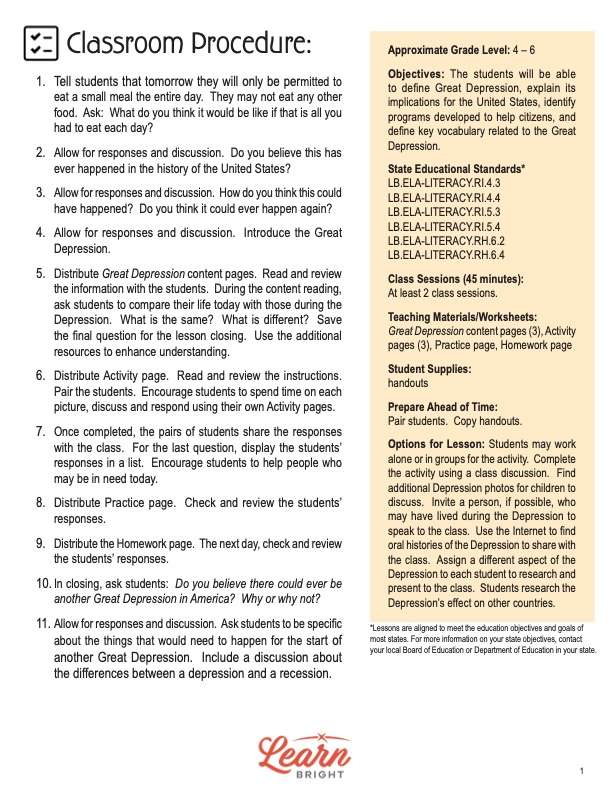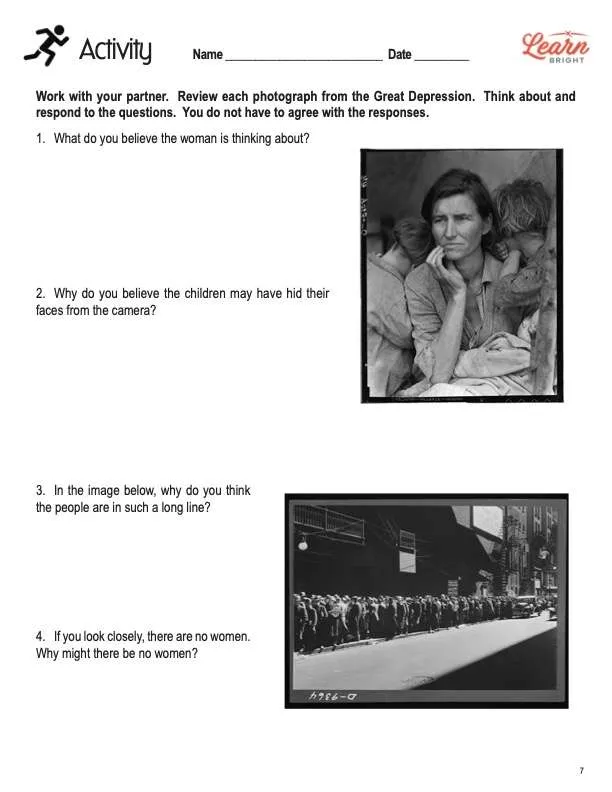Description
What our Great Depression lesson plan includes
Lesson Objectives and Overview: Great Depression introduces students to this historic period in the United States between 1929 and 1939. Students will learn about its impact on the country and its influence on the future decisions of the government. They will also be able to explain its implications for the U.S. and identify the programs people developed to help citizens. This lesson is for students in 4th grade, 5th grade, and 6th grade.
Classroom Procedure
Every lesson plan provides you with a classroom procedure page that outlines a step-by-step guide to follow. You do not have to follow the guide exactly. The guide helps you organize the lesson and details when to hand out worksheets. It also lists information in the orange box that you might find useful. You will find the lesson objectives, state standards, and number of class sessions the lesson should take to complete in this area. In addition, it describes the supplies you will need as well as what and how you need to prepare beforehand. For this lesson, the only supplies that you will need are the handouts. To prepare for this lesson ahead of time, you can pair students for the activity and copy the handouts.
Options for Lesson
Included with this lesson is an “Options for Lesson” section that lists a number of suggestions for activities to add to the lesson or substitutions for the ones already in the lesson. Students may work alone or in groups for the activity. Complete the activity using a class discussion. Find additional photos from the era for students to discuss. Invite a person, if possible, who may have lived during the Great Depression to speak to the class. Use the internet to find oral histories of the Depression to share with the class. Assign a different aspect of the Depression to each student to research and later present to the class. As one more idea, students could research the effect that the Great Depression had on other countries.
Teacher Notes
The teacher notes page includes a paragraph with additional guidelines and things to think about as you begin to plan your lesson. It mentions that it could be a good idea to use this lesson as an opportunity to share how life was different then compared to now. This page also includes lines that you can use to add your own notes as you’re preparing for this lesson.
GREAT DEPRESSION LESSON PLAN CONTENT PAGES
The Stock Market Crash
The Great Depression lesson plan includes four content pages. Normally, when you hear the word crash, you probably think about a car crash. However, on October 24, 1929, it was not a car crash that caused problems in America—it was the Stock Market crash. The stock market is a place where people trade, buy, and sell stocks (company ownership) and bonds (types of investments). The prices on the stock market can rise and fall each day.
During the summer of 1929, people in the United States were not spending money on goods and services. That meant there were extra products left unsold, and the production of those goods slowed down. At the same time, stock prices were rising. The people buying and selling stock realized the stock prices would start falling, so many people began selling their stock.
On October 24th, a record 12.9 million shares of stock were traded. The day became known as Black Thursday. Several days later was Black Tuesday, when 16 million shares of stock were traded. The shares of stock became worthless, and the many investors who had purchased shares using borrowed money went broke and nearly penniless. The stock market bubble had burst. Millions of people lost their life savings almost overnight.
People stopped spending money, factories stopped production, and workers everywhere lost their jobs. Salaries also decreased for those who were lucky enough to be working. In addition, people lost their homes and other possessions. The Stock Market crash of 1929 spread throughout the world, especially in Europe. The crash marked the beginning of the Great Depression.
More than Depressing
The crash was the first of many dominoes to fall leading to problems throughout the country. Before the Depression began, farmers had new equipment and machinery and could grow plenty of crops. The excessive crops, though, caused the prices of food to drop. Farmers were not earning enough money—in fact, they were losing money. To make matters worse, a drought (lack of rain) in the Midwest started that lasted for nearly 10 years. With no rainfall, the soil turned to dust. In addition, many farmers lost their farms because they could not pay their bills.
In the 1920s, before the Stock Market crash, people could buy things on credit for the first time, meaning they could buy things and pay for it in the future. They would buy new products like cars, radios, washing machines, and much more. When the Stock Market crashed, people were unable to make payments on the products.
There were people throughout the country who once were rich but became poor. About 10,000 banks failed as well, and people lost their life savings. At that time, the government did little to help the banks survive. Other countries also owed billions of dollars from loans following World War I, but they could not pay back the money.
Many people blamed Herbert Hoover, who was president when the Great Depression began. Homeless people lived in places called shantytowns. And many of the people called these “towns” Hooverville. The homes were mostly shacks. Unfortunately, even apart from homelessness, there were many other hardships during the Depression.
Life During the Great Depression
Three years into the Depression, nearly 30 million people in America had lost their source of income. That equated to about 25% of the total population. Of those who did work, many only had jobs with part-time hours. There were nearly 300,000 companies that went out of business. Children left school to support their families, and companies saved money by paying them lower wages. Over 2 million boys and girls between the ages of 10 and 18 worked on farms or in factories, canneries, and mines.
There was a large gap between the rich and poor of the country. Because of the drought and the loss of profits in farming, the rural areas of America were hit the hardest. About 200,000 people moved to California. Some farmers left their families, and older children left home so the family would not have to worry about feeding them. In addition, long-term health issues also resulted due to poor diets and a lack of healthcare.
There were several ways families tried to save money during the Great Depression. They sewed their own clothes, cooked foods that could last several days, and planted gardens. They even postponed marriages, had fewer babies, and combined households to help needy relatives. Often, a family of six would be fed on about $5 a week. People planted vegetable gardens on vacant lots in the middle of a city.
The Struggle for Optimism
Since many people saved money by staying at home, board and card games became popular during to entertain themselves. The game of Monopoly was invented in 1933. Children loved playing the card game, Old Maid. And baseball was the most popular sport. Listening to the radio, stamp collecting, and visiting neighbors on porches became popular things to do as well.
When people did leave their homes, they went to movies, held family picnics, and attended church and church socials. They held bingo parties, played miniature golf, and went to dances. If they were fortunate, they enjoyed a soda at the corner drug store. The 1930s became the golden age for radios and the movie industry.
Though many people did their best and tried to remain optimistic, people were becoming hopeless and pessimistic as the Great Depression continued. Many Americans who once had full-time work and could take care of themselves and their families became embarrassed by
the situation. They were too proud sometimes to ask for help from others, and receiving charity stressed them out. Many men and women of the Depression blamed themselves for their predicament.
President Herbert Hoover did little to bring hope to most Americans, and things did not begin to change until Franklin D. Roosevelt became president in 1932. He restored hope to many Americans when he signed the New Deal into law within 100 days of his presidency.
The New Deal
The New Deal was a promise Roosevelt made to end the Depression. In the first 100 days of his presidency, Roosevelt created 42 new agencies and laws and pushed Congress to pass them. Some of the programs, which still exist today, included the following:
- Social Security: This funded a retirement system for older adults, and other programs for those who are unable to work. Nearly everyone has a Social Security number that the government uses to track job earnings.
- Securities and Exchange Commission (SEC): Because of the Stock Market crash, the SEC was created to prevent fraudulent activities on Wall Street, the economic center of America.
- Federal Deposit Insurance Corporation (FDIC): Banks failed during the Depression. The FDIC insured bank deposits, prevented the possibility of withdrawing money too quickly, and reduced bank failures.
- Civilian Conservation Corps (CCC): This group hired 3 million people over 10 years whose job it was to conserve public land by planting forests, building flood barriers, and maintaining roads and trails.
- Securities Act: This required corporations to share information with investors before issuing stock.
The New Deal included an end to the Prohibition as well, which was a law that banned alcohol. Instead, the government added taxes to the sale of alcohol to help raise money for the programs. In addition, they put programs in place to accomplish many important things. There were programs to help homeowners refinance and insure mortgages. Others helped create jobs and secure funding for construction projects. Still others helped pay farmers to plant certain soil-building crops.
It has been debated as to whether the New Deal ended the Depression, but it did help millions of people. In 1939, World War II began and the spending and the financing for the war is what some people believe truly ended the Great Depression.
GREAT DEPRESSION LESSON PLAN WORKSHEETS
The Great Depression lesson plan includes three worksheets: an activity worksheet, a practice worksheet, and a homework assignment. You can refer to the guide on the classroom procedure page to determine when to hand out each worksheet.
PHOTOGRAPHS ACTIVITY WORKSHEET
The activity worksheet asks students to work with a partner to look at photographs from the Great Depression and respond to specific questions about them. This allows students to use what they’ve learned during the lesson to place the photos into context. It also allows them to put themselves in the shoes of some of the people suffering during the Great Depression.
You can also have students work either alone or in groups for this activity, depending on your preference. You can also have your students discuss the pictures and their answers to the questions in a class discussion.
GREAT DEPRESSION QUESTIONS PRACTICE WORKSHEET
For the practice worksheet, students will answer two rounds of questions about the Great Depression. The first part of this worksheet asks them to answer questions grouped by topic — Stock Market, Black Thursday, Dust Bowl, Daily Life, and New Deal Agencies. The second part lists some miscellaneous questions, such as “Who was President when the Great Depression began?” The questions on this worksheet are strictly factual and require students to recall specific information from the lesson material.
GREAT DEPRESSION HOMEWORK ASSIGNMENT
The homework assignments includes three exercises. For the first exercise, students will describe how the Great Depression would have affected different groups of people, like homeless people, a 13-year-old-child, farmers, and investors. They must use vocabulary relate to the Great Depression in their answers.
The next exercise has students match New Deal programs with their descriptions. The final exercise has students answer a few basic questions about the Great Depression.
Worksheet Answer Keys
This lesson plan includes answer keys for the activity worksheet, the practice worksheet, and the homework assignment. The “answers” for the activity are simply suggestions or guidelines. In addition, some answers on the homework worksheet will vary given the nature of the prompts. If you choose to administer the lesson pages to your students via PDF, you will need to save a new file that omits these pages. Otherwise, you can simply print out the applicable pages and keep these as reference for yourself when grading assignments.










